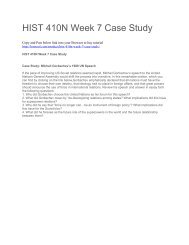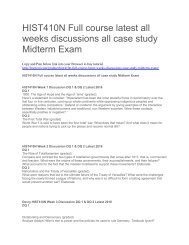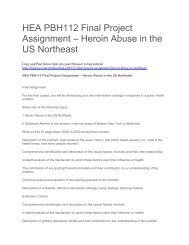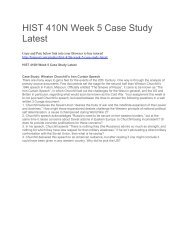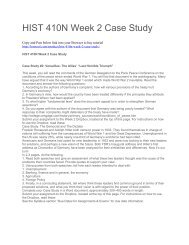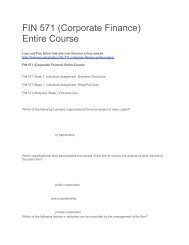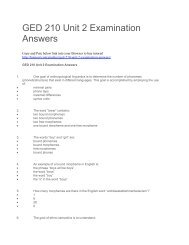GED 102 unit 4 examination answers
You also want an ePaper? Increase the reach of your titles
YUMPU automatically turns print PDFs into web optimized ePapers that Google loves.
<strong>GED</strong> <strong>102</strong> <strong>unit</strong> 4 <strong>examination</strong><br />
<strong>answers</strong><br />
Copy and Pate below link into your Browser to buy tutorial<br />
http://hwpool.com/product/ged-<strong>102</strong>-<strong>unit</strong>-4-<strong>examination</strong>-<strong>answers</strong>/<br />
<strong>GED</strong> <strong>102</strong> <strong>unit</strong> 4 <strong>examination</strong> <strong>answers</strong><br />
Multiple Choice Questions (Enter your <strong>answers</strong> on the enclosed answer sheet)<br />
1. The three mucosa-covered projections into the nasal cavity that greatly increase surface area of<br />
mucosa exposed to air are called ________.<br />
a. tonsils<br />
b. adenoids<br />
c. conchae<br />
d. paranasal sinuses<br />
2. The posterior portion of the palate that is not supported by bone is called the ________.<br />
a. soft palate<br />
b. paranasal sinus<br />
c. epiglottis<br />
d. hard palate<br />
3. From superior to inferior, the three regions of the pharynx are the ________.<br />
a. oropharynx, nasopharynx, laryngopharynx<br />
b. nasopharynx, oropharynx, laryngopharynx<br />
c laryngopharynx, oropharynx, nasopharynx<br />
d. nasopharynx, laryngopharynx, oropharynx<br />
4. The ________ tonsil, or adenoid, is located high in the nasopharynx region.<br />
a. lingual<br />
b. laryngeal<br />
c. pharyngeal<br />
d. palatine
5. The ________ routes air and food into their proper channels and plays a role in speech.<br />
a. tongue<br />
b. pharynx<br />
c. nasal conchae<br />
d. larynx<br />
6. The mucosa-lined windpipe that extends from the larynx to the level of the fifth thoracic<br />
vertebra is called the ________.<br />
a. trachea<br />
b. oropharynx<br />
c. main (primary) bronchus<br />
d. nasopharynxUnit 4 Examination 172 <strong>GED</strong> <strong>102</strong> The Human Body<br />
7. ________ lining the mucosa of the trachea beat continuously to propel contaminated mucus to<br />
the throat.<br />
a. Microvilli<br />
b. Coarse hairs<br />
c. Cilia<br />
d. Flagella<br />
8. The process of physically and chemically breaking food particles down is referred to as<br />
________.<br />
a. digestion<br />
b. defecation<br />
c. ingestion<br />
d. absorption<br />
9. The ________ runs from the pharynx through the diaphragm to the stomach.<br />
a. trachea<br />
b. esophagus<br />
c. larynx<br />
d. small intestine
10. The innermost layer of the alimentary canal is referred to as the ________.<br />
a. serosa<br />
b. submucosa<br />
c. mucosa<br />
d. muscularis externa<br />
11. The two intrinsic nerve plexuses serving the alimentary canal are the ________.<br />
a. solar; sympathetic<br />
b. submucosa; myenteric<br />
c. autonomic; somatic<br />
d. mucosa; submucosa<br />
12. The ________ sphincter, or valve, controls food movement from the stomach into the small<br />
intestine.<br />
a. ileocecal<br />
b. cardioesophageal<br />
c. pyloric<br />
d. analUnit 4 Examination 173 <strong>GED</strong> <strong>102</strong> The Human Body<br />
13. Large wrinkle-like folds in the stomach lining, present when the stomach is empty, that allow<br />
for expansion when the stomach is filling are called ________.<br />
a. villi<br />
b. haustra<br />
c. microvilli<br />
d. rugae<br />
14. The medial indentation where the ureter, blood vessels, and nerves are connected to the<br />
kidney<br />
is called the ________.<br />
a. renal capsule<br />
b. renal column<br />
c. renal pyramid<br />
d. renal hilum<br />
15. There are three regions of the kidney; the outermost region is known as the ________.
a. renal medulla<br />
b. renal cortex<br />
c. renal pelvis<br />
d. renal hilum<br />
16. Renal (medullary) pyramids are separated by extensions of cortex-like tissue called the<br />
________.<br />
a. renal columns<br />
b. renal pelvis<br />
c. renal hilum<br />
d. renal capsule<br />
17. The blood vessel carrying blood from the aorta into the kidney is the ________.<br />
a. hepatic artery<br />
b. renal artery<br />
c. renal vein<br />
d. glomerulus<br />
18. The functional <strong>unit</strong> of the kidney that filters blood and forms urine is the ________.<br />
a. glomerulus<br />
b. nephron<br />
c. renal pyramid<br />
d. renal pelvisUnit 4 Examination 174 <strong>GED</strong> <strong>102</strong> The Human Body<br />
19. The blood vessel directly feeding the glomerulus with blood from the cortical radiate artery is<br />
the ________.<br />
a. peritubular capillary<br />
b. efferent arteriole<br />
c. renal vein<br />
d. afferent arteriole<br />
20. The gonads produce sex cells, also known as ________,<br />
a. zygotes
. interstitial cells<br />
c. gametes<br />
d. spermatids<br />
21. Sperm are formed in tightly coiled tubes called seminiferous tubules that are found within<br />
each ________.<br />
a. spermatic cord<br />
b. testis<br />
c. ductus (vas) deferens<br />
d. epididymis<br />
22. The glands that produce a thick, yellowish secretion which nourishes and activates sperm are<br />
the ________.<br />
a. bulbo-urethral glands<br />
b. prostate<br />
c. seminal glands (vesicles)<br />
d. ejaculatory duct<br />
23. The ________ gland surrounds the upper portion of the urethra just below the junction with the<br />
urinary bladder.<br />
a. ejaculatory<br />
b. seminal<br />
c. bulbo-urethral<br />
d. prostateUnit 4 Examination 175 <strong>GED</strong> <strong>102</strong> The Human Body<br />
24. The enlarged tip of the penis is called the ________.<br />
a. glans penis<br />
b. shaft<br />
c. scrotum<br />
d. prepuce (foreskin)<br />
25. The male external genitalia include the ________ and the ________.<br />
a. testes; ductus (vas) deferens<br />
b. spermatic cord; glans penis
c. penis; scrotum<br />
d. seminal glands (vesicles); ejaculatory duct



